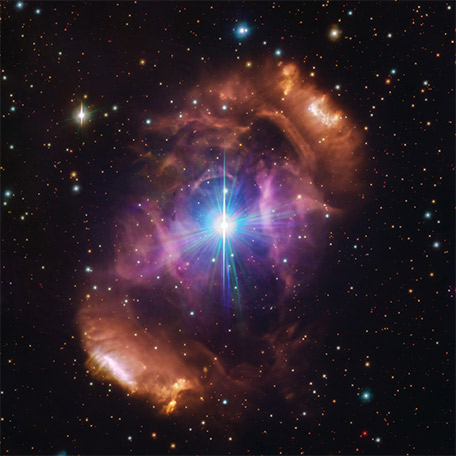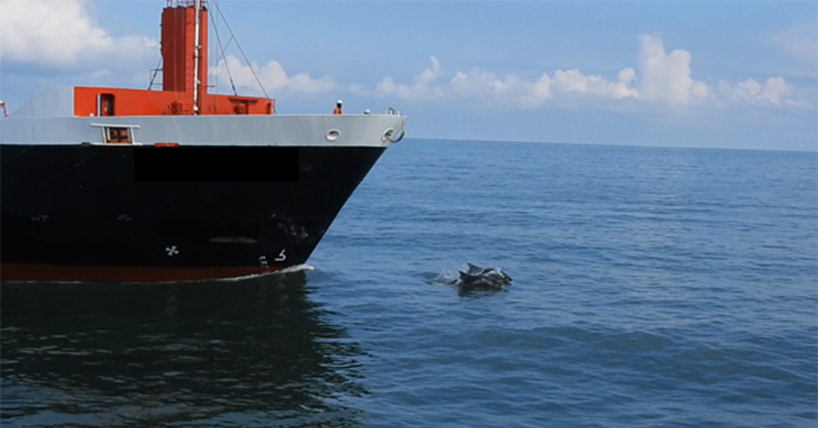Magnetic star
Astronomers solve merger mystery of a magnetic star
Published on: 12 April 2024
An international team of astronomers have unveiled the evolutionary history of a massive binary system, which unusually contains a magnetic star.
Publishing their findings in the journal Science, the team was led by Dr Abigail Frost from the European Southern Observatory (ESO) and included Newcastle University’s Dr Dominic Bowman.
The researchers looked at a stellar pair at the heart of a stunning cloud of gas and dust and were in for a surprise. Pairs of stars born together should have the same age, like twins, but in HD 148937 one star appears younger and, unlike the other, is magnetic.
This new study suggests there were originally three stars in the system, until two of them clashed and merged. This violent event created the surrounding cloud and forever altered the system’s fate. The system, HD 148937, is located about 3800 light-years away from Earth in the direction of the Norma constellation. It is made up of two stars much more massive than the Sun and surrounded by a beautiful nebula, a cloud of gas and dust.
“After a detailed analysis, we could determine that the more massive star appears much younger than its companion, which doesn't make any sense since they should have formed at the same time!” said Dr Frost, an astronomer at ESO in Chile and lead author of the study.
The age difference of 1.5 million years suggests something must have rejuvenated the more massive star. Another piece of the puzzle is the nebula surrounding the stars, known as NGC 6164/6165. It is 7500 years old, hundreds of times younger than both stars. The nebula also shows very high amounts of nitrogen, carbon and oxygen. This is surprising as these elements are normally expected deep inside a star, not outside; it is as if some violent event had set them free.
“We think this system had at least three stars originally; two of them had to be close together at one point in the orbit whilst another star was much more distant,” explains Prof Hugues Sana from KU Leuven in Belgium and co-author of the study. “The two inner stars merged in a violent manner, creating a magnetic star and throwing out some material, which created the nebula. The more distant star formed a new orbit with the newly merged, now-magnetic star, creating the binary we see today at the centre of the nebula.”

A star’s future evolution
This scenario also explains why one of the stars in the system is magnetic and the other is not — a peculiar feature of HD 148937. At the same time, it helps solve a long-standing mystery in astronomy: how some massive stars get their magnetic fields. While magnetic fields are a common feature of low-mass stars like our Sun, more massive stars cannot sustain magnetic fields in the same way. Yet some massive stars are indeed magnetic. Astronomers had suspected for some time that massive stars could acquire magnetic fields when two stars merge. But this is the first time researchers find such direct evidence of this happening. In the case of HD 148937, the merger must have happened recently.
“Magnetic fields in massive stars are particularly interesting because they can drastically change a star’s future evolution", says Dr Dominic Bowman, Reader in Astrophysics at Newcastle University and co-author of the study. "The photometric variability caused by pulsations in massive stars can be used to study a star's deep interior, which is the subject of the ongoing SYMPHONY project at Newcastle University. With HD 148937, we have a fantastic new piece of the puzzle to better understand massive star evolution including magnetic fields."
Funding:
The research received funding from UK Research and Innovation (UKRI) in the form of a Frontier Research grant under the UK government’s ERC Horizon Europe funding guarantee (SYMPHONY; PI Bowman; grant number: EP/Y031059/1), and a Royal Society University Research Fellowship (PI Bowman; grant number: URF\R1\231631).
References:
Frost, A. J., Sana, H., Mahy, L., Wade, G., Barron, J., Le Bouquin, J.-B., Mérand, A., Schneider, F. R., Shenar, T., Barbá, R. H., Bowman, D. M., Fabry, M., Farhang, A., Marchant, P., Morrell, N. I., & Smoker, J. V. (2024). A magnetic massive star has experienced a stellar merger. Science, 384(6692), 214–217. https://doi.org/10.1126/science.adg7700
Press release text and figures adapted with thanks from European Southern Observatory.

.jpg)

